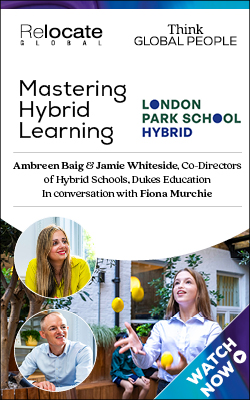STEAM: embedding the skills for tomorrow, today
The jobs children at school now will have in future will be influenced by the net-zero agenda, climate change and technology. Having the subject knowledge and skills to tackle these makes STEAM essential in education today.

Related reading from Relocate Global
- How to choose the right university for your globally mobile teen
- Mission Discovery Space and STEM with ISSET and NASA
- Reach for the stars with NASA and ISSET
What does STEAM mean in education today?
“STEAM is science, technology, engineering, art and math,” says Steven Katz, who has taught at ISKL since 2015 and an Apple Distinguished Educator. “But STEAM is transdisciplinary, where we are doing all these things together rather than teaching them apart, as traditionally has been the case.The transdisciplinary approach to STEAM is different to much STEM teaching in the past, which historically often focused just on science and maths. The STEAM approach is more future focused, not just from what employers are looking for, but also for all-round employability.“There’s definitely shortages in these fields,” says Steven Katz. “It’s important that we are focusing on them, especially the area of coding, which has a huge deficit of jobs. In addition to that, in these fields there’s definitely an under-representation of women and people of colour, so to try and diversify this field I think is important.“It's also important that we are teaching children the thinking skills to solve problems within this integrated pedagogy.”The importance of creativity
“Having the extra element of creativity through the arts is really key,” agrees Ryan Ball, a DT educator with 20 years’ classroom experience, including as head of art, at international schools in the UK, Middle East and Asia.“In the UK, we have a subject called design and technology [DT]. This seems to encompass the while of STEAM really. I’m passionate about it as an educator and a parent as well. I want my kids to explore and have these experiences because there are so many opportunities available through STEAM and how it opens up the soft skills – not a term I particularly like – around problem-solving, curiosity and resilience.”These skills have real value in the emerging world of work. “One of the things we do is really focus on the design cycle,” says Steven Katz. “Having kids go through a process over and over in order to come up with a solution to a problem. We keep having different iterations of that first iPhone for example. We want to get the kids thinking in that same way because it’s really a life skill.”A question of perception?
Until recently, the separate subject of DT and STEAM generally have not necessarily been well-received by parents and government policymakers, who often regard qualifications in this area as less valuable than core academic subjects to getting on in life. However, as the WEF’s projections show, these perceptions may need to change.“Parents have a really important part to play in kids’ education,” says Ryan Ball. “From my own experience in the last 20 years, DT is often a misunderstood subject and sometimes thought of as being – and I’ll use inverted quote marks – ‘for the less able’. “When I was school and then when and I just started teaching, it was thought of as a subject for children ‘who were good with their hands’ or ‘less academic’. It used to really irk me. But it isn’t that. It allows lots of students to access the curriculum and learning in general. “But it’s also something I found that the more academically able students, if you want to call them that, often found really hard. To have something where there isn’t a right answer, and it’s not directly from a textbook, and they’ve got to use their problem-solving skills and come up with a creative solution, is something a lot of kids really find tricky. We had to spend quite a lot of time in all the schools I’ve worked in to really try and dispel those myths and tell them it is a really vital subject.”“In our elementary school, we invite parents in to see what’s going on in the classroom,” says Steven Katz, as he explains how ISKL are helping to lead the way in STEAM education in Asia. “In elementary school DT/STEAM is not a separate subject. There is some merit in teaching design and technology separately, especially at higher levels, but here at ISKL we integrate it into the curriculum so we are improving teaching and learning.”Real-world learning
Describing how this approach works with a fourth-grade class setting up a model city, building houses and wiring them with electricity, Steven Katz says, “Most kids if you ask them to build a house will cut out six pieces and glue them together. My contribution as Technology Coordinator to that was teaching them how to take a 2D template and make it into a 3D shape. Developing those skills in design fit really nicely with what they are doing already.”“That’s something the best schools do in terms of that context,” says Ryan Ball. “Steve touched on it brilliantly when he was talking about the electrical circuits – teaching the difference between a parallel and a serial circuit for instance. By putting them in the context of something the students are familiar with, like housing, kids will really retain that information and see how it helps them in the big wide world.“This is the sort of thing we say to parents: it’s all around you. The man-made world has been designed, manufactured, built by somebody and they have gone through the process that your child is going through at school. It might be with different materials and timescales, but they are handling materials, understanding the properties of things and putting together all of their learning from maths, science, engineering, arts to put together a tangible, real and useful solution. That’s where the magic happens.”Find out more here
@Watch the full webinar, 'The importance of STEAM for children and the future' here. See the bios for Ryan Ball, Director of Education, Design and Technology Association and Steven Katz, ES Coordinator, The International School of Kuala Lumpur (ISKL). For the latest insights into international schools, read more in our International Education and Schools Fair section and International Education and Schools Guide.
©2025 Re:locate magazine, published by Profile Locations, Spray Hill, Hastings Road, Lamberhurst, Kent TN3 8JB. All rights reserved. This publication (or any part thereof) may not be reproduced in any form without the prior written permission of Profile Locations. Profile Locations accepts no liability for the accuracy of the contents or any opinions expressed herein.









































